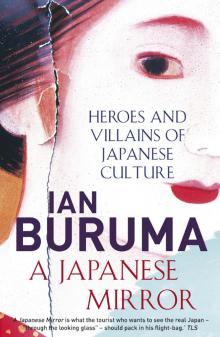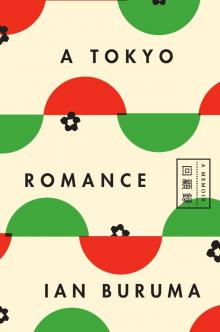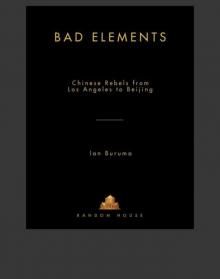- Home
- Ian Buruma
A Japanese Mirror
A Japanese Mirror Read online
A JAPANESE MIRROR
Ian Buruma was born in The Netherlands in 1951. After studying Chinese literature and history at Leyden University he left for Japan in 1975 to study cinema at Nihon University College of Art. He spent almost seven years in Tokyo, writing, making films and acting in the modern Japanese theatre. He is currently the Henry R. Luce Professor of Human Rights and Journalism at Bard College. He lives in New York.
First published in hardback by Jonathan Cape Ltd, 1984
This paperback edition published in Great Britain in 2012 by
Atlantic Books, an imprint of Atlantic Books, Ltd.
Copyright © Ian Buruma, 1984
Preface copyright © Ian Buruma, 2012
The moral right of Ian Buruma to be identified as the author of this work has been asserted by him in accordance with the Copyright, Designs and Patents Act of 1988.
All rights reserved. No part of this publication may be reproduced, stored in a retrieval system, or transmitted in any form or by any means, electronic, mechanical, photocopying recording, or otherwise, without the prior permission of both the copyright owner and the above publisher of this book.
The picture acknowledgements on pp vii-viii constitute an extension of this copyright page.
Every effort has been made to trace or contact all copyright holders. The publishers will be pleased to make good any omissions or rectify any mistakes brought to their attention at the earliest opportunity.
10 9 8 7 6 5 4 3 2 1
A CIP catalogue record for this book is available from the British Library.
Paperback ISBN: 978-1-84354-962-8
E-book ISBN: 978-1-78239-836-3
Printed in Great Britain
Atlantic Books
An imprint of Atlantic Books Ltd
Ormond House
26–27 Boswell Street
London
WC1N 3JZ
www.atlantic-books.co.uk
For Sumie
Contents
Preface
1
Mirror of the Gods
2
The Eternal Mother
3
Holy Matrimony
4
Demon Woman
5
The Human Work of Art
6
The Art of Prostitution
7
The Third Sex
8
The Hard School
9
The Loyal Retainers
10
Yakuza and Nihilist
11
Making Fun of Father
12
Souls on the Road
13
Conclusion: A Gentle People
Notes
Index
Illustrations
Plates
1
An old fertility stone
2
A fertility goddess
3
Two fertility stones
4
Dance of The Dread Female of Heaven
5
Striptease, Japanese style
6
The lovers in Mizoguchi’s Taki no Shiraito
7
Chutaro being rejected by his mother (Mother Behind My Eyes)
8
The Mother of Japan trying to retrieve her son (A Japanese Tragedy)
9
Imamura Shohei’s favourite woman, Hidari Sachiko, in Insect Woman
10
Mother and son, in a print by Utamaro
11
The ‘Goruden (Golden) Combi’
12
Pathos in a ‘homu dorama’
13
The threatening female
14
Tani Naomi dominating her slavish benefactor in Tanizaki’s A Fool’s Love
15
The old man worshipping his daughter-in-law’s feet (Diary of a Madman)
16
Torture in a run-of-the-mill porn film
17
Tani Naomi being tortured in Rope and Skin
18
An Edo period courtesan, in a print by Utamaro
19
Modern Japanese amusing themselves at a geisha party
20
Scene in a ‘Toruko’ massage parlour
21
Female stars playing romantic male leads (Rose of Versailles)
22
Tamasaburo playing an Edo period courtesan
23
Romance in the Takarazuka theatre
24
Yoshitsune as a fighting bishonen
25
Kirokku in a fighting mood (Elegy to Fighting)
26
A hero of the Hard School
27
Kamikaze pilots
28
The assassination attempt on Moronao in Chushingura
29
A tattooed yakuza hero
30
Death of the oyabun
31
Sugawara Bunta shooting his opponent (Fighting Without Nobility)
32
Takakura Ken purifying his sword with saké
33
Sugawara Bunta, the nihilist hero
34
Good old Tora-san
35
Crowds queuing to see the newest Tora-san film
Figures
Examples from comic-books appear on pages 106, 108–9, 120, 126, 127, 138, 144 and 146.
Preface
Few things date as fast as popular culture and few cultures are as open to new waves, new fashions, new slang, newness of any kind, as the Japanese. Because of the nature of modern mass media – television, Internet, mobile phones – the process of renewal is going ever faster. The most widely read Japanese novels today, albeit almost exclusively by young women, are popular romances serialized almost by the hour on mobile phones. Once popular genres like ‘romantic’ porn films, produced in large numbers by the Nikkatsu studios, have disappeared. As is true in most countries, pornography has shifted almost entirely to the Internet, where it is all much more hard core.
When I wrote A Japanese Mirror in the early 1980s, all this was inconceivable. To a Japanese born in 1983, when the book was first published, most of the characters and stories described in the book, from yakuza heroes to the heart-throbs in girls’ manga, are probably wholly unknown.
To be sure, there are still people – young people, even – who enjoy reading novels by Tanizaki, and watching films by Ozu, Kurosawa, and Mizoguchi. Some may even be buying old manga. But these are becoming rarified tastes and they can no longer be classified as popular culture.
Japanese fashion – Kenzo, Kansai, Mori – was already well established in the 1970s, especially in Paris, and there was an art house (remember those?) audience for Japanese cinema in the larger European and American cities. But even in the early eighties, Japan was still an exotic country to most people. The worldwide popularity of Japanese anime had not even begun. The enormous fame of the Murakamis (Haruki, the writer, and Takashi, the artist) was yet to come, as was the consumption of sushi as a global food. In fact, it is the very lack of exoticism that makes Murakami’s novels accessible to readers everywhere. The same is probably true of Murakami Takashi’s ‘cult of cute’. And the hunger for raw tuna is so universal that these great fish are destined soon to disappear from the seas.
To a contemporary reader, then, A Japanese Mirror will now have acquired a patina of age. Not that everything I wrote about in the book was new even in 1983. Far from it; some of the culture I tried to hold up to the light went back as far as the 11th century. But even historical description reflects the time when it was written. Thus, the atmosphere of the book is of a different Japan from the country today.
There are links, of course, between the present time and the pop culture of the 1970s, and, if you look hard enough, the 11th century. The sweetness and cruelty of Murakami Takashi’s slick modern art, derived from comic books and anime, can be found in Japanese art and entertainment of the quite distant past. Likewise, some of the sexual fantasies projected on the Internet today can doubtless still be discerned in different forms in the movies, comic books, or 18th century woodblock prints described in the book. Often, if you study the artistic expressions of an old nation, you will find continuities behind the façade of constant change. I suppose that is what we might call ‘national identity’.
To give some idea of this identity, of Japaneseness, was one of my aims in writing the book. Hence the comparisons of modern striptease parlors with ancient Shinto fertility rites, or of young heroes in girls’ comics with the rakes of Murasaki Shikibu’s 11th century The Tale of Genji, or 18th century Japanese Robin Hoods with modern gangster pictures, and so on.
There is a risk involved in such intellectual enterprises, of going on a wild goose chase for something essential in a culture that is far too varied and fluid to be reduced in that way. Certain Japanese intellectuals, perhaps as a reaction to more than a hundred years of rapid and sometimes abject Westernization, are prone to pinpoint and celebrate the uniqueness of Japaneseness. This can serve as a theoretical justification for crude chauvinism. The ‘theory of Japaneseness’, Nihonjinron, was so fashionable for a time, especially in the seventies and eighties, that many Western visitors mistook it for a true picture of Japan. Not only was Japan presented as unique in such theorizing, but also as uniquely unique.
In fact, many things claimed by the theorists to be uniquely Japanese are simply human and can be recognized in many places, far removed from Japan. The great scholar of Japanese culture, Ivan Morris, wrote a highly entertaining study of historical Japanese heroes entitled The Nobility of Failure; I was indebted to many of his insights when I wrote my book. But he too gave too much credence to the theories of uniqueness. The noble failures he describes – warriors who die for hopeless causes, from Yamato Takeru in the 4th century to the kamikaze pilots of the Second World War – are to be found in the histories of all nations. Remember, for example, the Alamo, or Masada: most nations have their share of hopeless causes and noble failures.
In trying to sail between the Scylla of cultural uniqueness and the Charybdis of vapid universalism, I aimed to show that although the Japanese have a distinct culture, they are not exotic, or weird, or utterly ‘other’, but human like everyone else. Which leaves us with the question: who are ‘the Japanese’? It is a common fallacy in national history museums, meant to instill a sense of belonging, common purpose and patriotism, to present a timeless vision of a people, as though the Gauls in Roman times were essentially the same people as the modern French, or the people of the Jomon period (14,000-4,000 BCE) already shared typical characteristics with today’s Japanese readers of Murakami Haruki. This is, of course, patent nonsense. Any decent stab at history, including the history of pop culture, must explain change as much as continuity.
A Japanese Mirror is about the ways in which Japanese imagine and reimagine themselves, about fantasies and stories. Naturally, these reflect different times and circumstances. Japanese growing up in the militarized 1930s had different fantasies and different heroes from most Japanese today. In a sense, they were a different people, who happened to speak roughly the same language and eat roughly the same kind of food. And yet, just as the Scylla of uniqueness cannot be entirely avoided, one can’t help noticing certain continuities.
It would be a categorical mistake to take these continuities in the popular imagination as accurate descriptions of what the Japanese are actually like in real life. Our heroes and villains can certainly reveal important things about us, but these often stand in contrast to reality. In their imaginary world – expressed in books, pictures, movies, comics, anime, or computer games – the Japanese often admire the heroic loner, the outlaw who pays the price of nonconformity by being a permanent outsider, rather like typical heroes in American Westerns. In fact, Japanese society is marked by a high degree of conformity. Community is highly prized and social isolation is seen as one of the cruelest punishments imaginable. Few people really want to be loners, which is precisely why the outsider is a romantic hero. As the parallel with American Westerns shows, this is not unique to Japanese culture, but (like the nobility of failure) it is certainly a prominent feature of it.
Something that is often ignored by students of cultures is the question of class. Much popular culture is aimed at the lowest common denominator. Some entertainments tell us more about the class of people who enjoy them, than about an entire nation. If one were to define Italian society by the quality of its television shows, one would arrive at an oddly skewed picture. The same is true, obviously, of Japan. Television in Japan tends to be divided between a kind of non-stop slapstick (on the private channels) and deadly earnestness (on NHK, the public broadcaster). Again, the contrast with real life is instructive, especially in the case of the slapstick. People appearing in game shows, quiz shows, chat shows, or comedy shows, tend to dress up in zany costumes, laugh crazily, and screech and jump about like hysterics. Their behaviour, in other words, is the opposite of common everyday Japanese behaviour which is, on the whole, modest, restrained, undemonstrative – even timid. Showtime is a chance to let down one’s hair, and for others to enjoy this spectacle vicariously. The question, which is more authentic, the screeching or the restraint, I shall leave to the psychologists.
Because culture has changed since 1983, A Japanese Mirror cannot and should be read as a definitive take on the Japanese character. To be definitive about anything that is subject to change is impossible, and there is probably no such thing as ‘the Japanese character’ anyway, certainly not a definitive one. It is for this reason that I have resisted the temptation to update the book by adding new fashions and fads; by the time you read this, those too might be dated. What I wrote about at the time were things that happened to fascinate me, in film, in print, on stage. If these fascinations added up to a kind of portrait of a people, so much the better. They could also be read as a kind of portrait of myself, as I was then. In the life of a writer, too, there are changes and continuities.
So I offer you the book again, without revision. Cyril Connolly once wrote that any book still in print after nine years is a classic. There may have been an element of self-consolation, of hope more than conviction, in this statement. He was never a best-selling author, but his best books do keep popping back into print. I hope A Japanese Mirror survives as a classic book on Asia, in the company of J. R. Ackerley’s Hindoo Holiday, Robert Byron’s The Road to Oxiana, and Simon Leys’s Chinese Shadows. But that, my dear reader, is for you to decide.
The mirror, they say, ‘reflects eternal purity’. It does not foster vanity nor reflect the ‘interfering self’. It reflects the depth of the soul.
Ruth Benedict, The Chrysanthemum and the Sword
1
Mirror of the Gods
Man has always created gods in his own image. The Japanese are no exception. The oldest gods and myths are not necessarily unique to Japan. Some of them probably originated on the Asian continent, but they were soon adapted to a Japanese way of life and thinking.
In the beginning, however, there were no gods at all. There was, instead, something resembling an egg. Out of this egg came seven generations of gods, including a brother and sister called Izanagi and Izanami. It is with them that the Japanese myth really began.1
These two were groping around in the hot lava of Chaos with the ‘Jewel-spear of Heaven’ when some brine dropped off its tip, coagulating in the sea to make an island. On this island they erected a phallic pillar separating Heaven and Earth. Then they noticed that he had something she did not and decided to put two and two together. The art of kissing was learnt by watching a pair of amorous doves and the rest of the
happy union was inspired by the movements of a wagtail.
Izanami gave birth to the Japanese islands as well as to a large number of deities, but the god of fire proved to be too much for her. During his painful birth, she badly burnt her genitals. And after one last exertion whereby she bore the gods of metal, clay and water from her vomit, faeces and urine, Izanami perished and disappeared into the nether regions.
She was followed into the underworld by her grief-stricken brother/husband. She begged him not to look at her in her horrible state, but he could not resist a peek, and seeing her putrifying body swarming with maggots, he exclaimed: ‘What a hideous and polluted land I have come to unawares!’
Thus shamed, the furious Izanami sent the Ugly Females of the Underworld after him with the express order to kill him. He barely managed to escape from these furies and then he was able to stop his sister/wife from catching him only by blocking her way with a rock. Shaken by these events, he announced his divorce from her in the traditional Japanese manner: a word from the husband was enough to sever the relationship. In retaliation Izanami vowed that she would strangle a thousand people a day in his land. Whereupon he replied that he would set up fifteen hundred houses for childbirth in one day.
Back from the underworld, Izanagi took great pains to purify himself from the pollution of the dead. He had a thorough bath in the Tachibana river and once again deities were born: Amaterasu, the Sun Goddess, crawled out of his left eye, and her brother Susanoo, the Wind God, emerged from his nose. Amaterasu was allotted the Plain of High Heaven and Susanoo was put in charge of the seas. Far from happy to accept this duty, however, he howled and screamed, desperate to be with his mother in the underworld. But before his descent into the land of darkness, he decided to pay his sister a visit in Heaven.

 A Japanese Mirror
A Japanese Mirror Taming the Gods
Taming the Gods The China Lover
The China Lover A Tokyo Romance
A Tokyo Romance Theater of Cruelty
Theater of Cruelty Year Zero
Year Zero The Wages of Guilt
The Wages of Guilt Murder in Amsterdam
Murder in Amsterdam Bad Elements
Bad Elements Their Promised Land
Their Promised Land Occidentalism
Occidentalism Anglomania
Anglomania Inventing Japan: 1853-1964 (Modern Library Chronicles)
Inventing Japan: 1853-1964 (Modern Library Chronicles) The Missionary and the Libertine
The Missionary and the Libertine